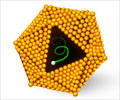In a new study published online this week in the open access journal PLoS Biology, Benoît Kornmann, Ueli Schibler, and colleagues investigated circadian genes in the liver
Anyone who has experienced jet lag will understand the importance of a smooth-running circadian clock. Crossing time zones decouples our biological rhythms from the natural cycle of light and dark we’re used to. We perceive light cues through retinal photoreceptors that relay signals to the suprachiasmatic nucleus (SCN) in the brain.
"Phase adjustments" in peripheral tissues ensure that each clock follows the same schedule. These can be set indirectly through SCN-dependent biological rhythms, such as feeding cycles or body temperature. How synchronizing cues operate at the molecular level, however, remains obscure. One key question is whether cyclically expressed genes in peripheral tissues are controlled by local circadian clocks or by systemic cues that are directly or indirectly controlled by the SCN pacemaker.In a new study published online this week in the open access journal PLoS Biology, Benoît Kornmann, Ueli Schibler, and colleagues investigated circadian genes in the liver to try and answer this question. To determine whether genes were under local or systemic control, they generated a mouse strain with conditionally active liver clocks that they could turn on or off at will.
The authors modified a transcription factor called REV-ERBa that shuts down circadian gene expression via suppression of a clock gene Bmal1. The modified gene had tetracycline-responsive elements (TREs) that respond to tetracycline and similar antibiotics. Mice with this modification were bred with a strain carrying a gene construct that activates the elements specifically in liver cells. In transgenic offspring fed with tetracycline-like doxycyline (Dox), Rev-erba remained silent in liver cells and Bmal1 functioned normally. In the absence of Dox, transgenic offspring overexpressed REV-ERBa, and Bmal1 was inactive, effectively turning off the liver clocks.
When the authors performed a genome-wide scan of the expression of genes targeted by BMAL1 in the presence and absence of Dox, they found arrhythmic expression of most of the targeted clock genes when the liver clocks stopped, as expected. However, some genes, including the known clock gene mPer2 displayedrhythmic expression even when Bmal1 was inactive. This is noteworthy because in brain tissue from transgenic mice lacking Bmal1, mPer2 transcripts in SCN neurons are barely noticeable during the course of a day.
It’s possible that mPer2 transcription is more dependent on BMAL1 in the SCN than it is in the liver, however the authors considered two other explanations for the observed mPer2 activity: either the mice that didn’t eat Dox still harbored enough BMAL1 to drive cyclic mPer2 expression or oscillating systemic signals were responsible. To distinguish between these, they analyzed temporal mPer2 expression in isolation from master pacemaker signals by removing liver slices from mice carrying a fluorescent protein attached to mPer2. With this approach, luminescence signals showed a rhythmic profile that follows mPer2 activity.
The authors bred the mouse strain with the conditionally active liver clock with a strain carrying the mPer2 fusion gene. As expected, liver slices from the offspring without Dox did not exhibit circadian mPer2 expression; the liver oscillators had therefore been shut off. However, when Dox was added to the medium supporting the liver tissue, circadian rhythms matched those seen in livers from mice with fluorescent mPer2 and unimpeded Bmal1 expression. The mPer2 expression patterns in the liver explants together with in livers taken from the transgenic offspring show that liver oscillators can drive circadian gene expression in the absence of systemic cues and that systemic cues can do so in the absence of liver oscillators.
Advertisement
By controlling liver clock function with the flip of a molecular switch, the authors showed that only 10% of circadian genes follow temporal expression patterns in the absence of liver oscillators. The authors think these genes probably respond to physical or chemical signals controlled by the master SCN pacemaker. mPer2 is a strong candidate as one of the systemically regulated synchronizers because its expression pattern is almost identical with or without a functional liver clock. A systemically driven mPer2 transcription cycle would provide the necessary link to synchronize the phase of the peripheral oscillator to that of the central system.
Advertisement
Source-Eurekalert
SRI











